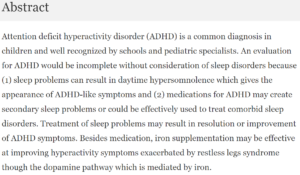
Why don’t doctors screen for obstructive sleep apnea during the annual routine physical?
After all, this condition causes many problems including high blood pressure, nocturia and morning headaches.
It’s also one of the most misdiagnosed and under-diagnosed medical conditions.
Symptoms of Sleep Apnea You May not Know
• Repeated need to urinate overnight (nocturia)
• Waking with a headache that quickly disappears once you’re out of bed
• Difficulty concentrating and focusing throughout the day
• Unexplained irritability
• High blood pressure that doesn’t respond to medication, exercise or changes in diet
The above symptoms can also have other causes, but doctors need to consider obstructive sleep apnea (OSA) on the differential diagnosis list.
Thin Young People Can Have Obstructive Sleep Apnea

“Most people think of OSA as associated with obesity, but it’s now understood that it is not just obesity, but actually the anatomical structures of the upper airway that can cause obstructive sleep apnea,” says Dr. C. Phillip Amoils, MD, a board certified otolaryngologist with SC-ENT Ear, Nose & Throat Specialists in CA.
“So if there’s a narrowed jawbone or mandible, or a retracted mandible with a large tongue, then OSA can occur — even in people who are lean and fit,” continues Dr. Amoils.
“In the old days, anybody who was obese was assumed to have OSA, whereas today we are realizing that it’s the relationship between anatomical structures like the jaw, the maxillae, the tongue base and the back of the throat (called the pharynx) that causes sleep apnea.
“And this can be found in kids with big tonsils, young females with narrow airways, and many others — so there is a whole group of patients whom family practice doctors are not looking at because they assume that they would be normal.”
If you’re struggling with any of the above-mentioned symptoms, take a look in the mirror.
• Do your jaw and chin appear small?
• Do you have a small mouth?
• Are a few of your teeth crowded out of alignment?
• Did you ever have to have your wisdom teeth removed?
• Does your tongue always have indents from your teeth?
These features are red flags for – but don’t 100 percent guarantee – sleep-disordered breathing.
These signs of things just being too small and crowded can mean a more easily-obstructed airway during sleep when all the structures become quite relaxed.
Additional Risk Factors for Sleep Apnea not Related to Obesity
• Alcohol consumption close to bedtime. This can overly-relax the throat tissues.
• Smoking. This can cause inflammation of the throat tissues, leading to a collapsed airway during sleep.
• Chronic heart failure. This disease is associated with central sleep apnea, when the brain “forgets” to tell the body to breathe.
The patient may be thin and female, not just the stereotypical fat man with a thick short neck.
Adult or Child Diagnosed with ADHD?

Shutterstsock/Anastasiia Markus
The symptoms of adult and pediatric ADHD are similar enough to untreated OSA to result in a misdiagnosis.
Continued non-restorative sleep easily leads to behavioral and cognitive symptoms during the daytime that are very similar to ADHD.
Check this abstract out from a paper in Pediatric Neuropsychiatry (Oct. 2018):

Doctors Not Considering Sleep Apnea As a Cause of Troubling Symptoms
So not only do many doctors fail to consider obstructive sleep apnea as a cause of a non-overweight patient’s various symptoms, but the misdiagnosis as ADHD, chronic fatigue syndrome, mental stress and/or lack of exercise happens way too often.

Dr. Amoils is considered among the best surgeons worldwide for sinus surgery and OSA, having helped thousands of patients for 25+ years. He also demonstrates to physicians the protocols he’s developed for mouth breathing, nasal congestion, obstructive sleep apnea and snoring using minimally invasive procedures.
 Lorra Garrick has been covering medical, fitness and cybersecurity topics for many years, having written thousands of articles for print magazines and websites, including as a ghostwriter. She’s also a former ACE-certified personal trainer.
Lorra Garrick has been covering medical, fitness and cybersecurity topics for many years, having written thousands of articles for print magazines and websites, including as a ghostwriter. She’s also a former ACE-certified personal trainer.
.











